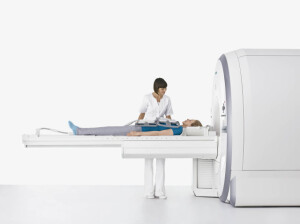by
Brendon Nafziger, DOTmed News Associate Editor | June 07, 2011

Siemens' Biograph mMR.
(Credit: Siemens)
Siemens Healthcare's whole-body integrated PET-MR system, the Biograph mMR,
received European approval last week. And now preliminary research suggests simultaneous PET-MR scans perform comparably when matched against PET-CT, in a study presented at the Society of Nuclear Medicine's annual meeting in San Antonio, Texas on Monday.
The idea behind PET-MR is that MR could offer new information about soft tissues, and also allow attenuation correction for PET without exposing patients to radiation from the CT scanner. But the technology isn't available in the United States yet, and research is just beginning.
However, in the study presented at SNM, a comparison between MR-attenuation-corrected PET-MR data and PET-CT data in the same patients showed comparable outcomes for a range of organs and lesions.



Ad Statistics
Times Displayed: 186572
Times Visited: 4976 For those who need to move fast and expand clinical capabilities -- and would love new equipment -- the uCT 550 Advance offers a new fully configured 80-slice CT in up to 2 weeks with routine maintenance and parts and Software Upgrades for Life™ included.
In the study, 11 cancer patients underwent dual-imaging, single injection PET-CT then PET-MR scans. Comparison between the two modalities was performed by a semi-quantitative analysis of tracer ([18F]FDG) uptake in different organs and lesions versus reference tissue (in this case, the musculature).
The simultaneous MR-PET acquisition was "feasible and good quality," the researchers said, with no significant difference for organ to reference ratios of tracer uptake for lung, liver, spleen and bone.
Median values were for lung/rf: PET-CT = 0.45, PET-MR = 0.39; liver/rf: PET-CT = 2.8, PET-MR = 2.3; spleen/rf: PET-CT = 2.2, PET-MR = 2.7; and bone/rf: PET-CT=2.7, PET-MR=3.6.
Plus, all 13 tumor-lesions detected in PET-CT could also be identified in PET-MR, with no significant difference in uptake ratios. Median lesion rf/ values were PET-CT = 6.4 and PET-MR = 9.6.
"This study demonstrates for the first time that newly introduced integrated whole-body MR/PET technology allows simultaneous acquisition of high-quality MR and PET data in a clinical setting within an acceptable time-frame," wrote the authors, led by Dr. Alexander Drzezga, with the Technical University of Munich, in Germany.
Drzezga serves as an investigator and adviser with the pharmaceutical company Bayer Schering, and another of the seven researchers in the group, Markus Schwaiger, serves as an investigator for Siemens Healthcare.

